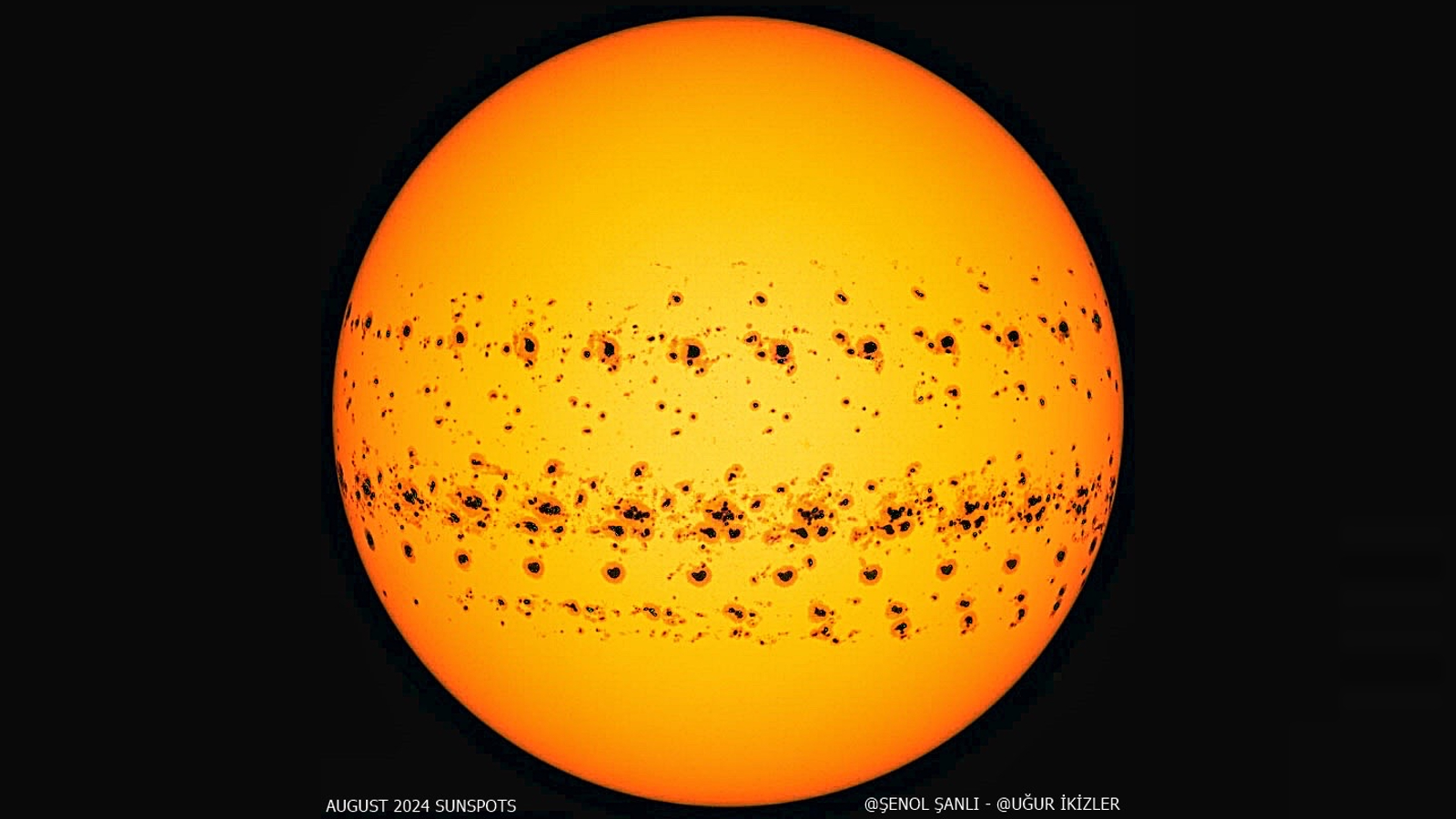Giant 'senior citizen' sunspot on 3rd trip around the sun could break a century-old record
A large sunspot has just reappeared on the sun's Earth-facing surface, almost two months after it first emerged. The unusually old dark patch remains stable and could be on course to become the longest-lived sunspot on record, experts claim.

A massive, "geriatric" sunspot is currently making its third trip across the sun's Earth-facing surface, around two months after it first appeared. The senior citizen has lasted far longer than most other solar blemishes and looks like it might persist for a while longer, potentially breaking a centuries-old sunspot longevity record.
The giant dark patch, currently named AR 14100, is located on the sun's northern hemisphere, just above the solar equator. It first emerged on April 5, when it was dubbed AR 14055, before disappearing from view as it rotated onto the sun's far side. It then reappeared on April 28, and was renamed AR 14079, before disappearing from view once again and reemerging on Monday (May 26) with a new name. (Sunspots get a new name every time they reappear on the sun's near-side to help researchers better track their space weather potential.)
The hefty spot has fluctuated in size as it's spun around our home star. It reached its maximum size in early May (when it was labeled AR 14079), spanning 87,000 miles (140,000 kilometers) across — roughly the equivalent of 11 times Earth's diameter. This made it the largest sunspot of 2025 so far, but it is now around half the size.
Most sunspots last only around a week, while some of the larger ones can sometimes survive long enough to reappear after transiting the sun's far side, which takes approximately two weeks. But it is rare for the dark patches to live any longer, even when they are this large. To compare it to human lifespans, AR 14100 is most definitely a "senior citizen," according to Spaceweather.com.
"Contact the AARP [formerly the American Association of Retired Persons]," Spaceweather.com representatives wrote. "Sunspot 14100 wants to join."
Related: 10 supercharged solar storms that blew us away in 2024

It is hard to tell what the record for the longest-lived sunspot is because historical data is far less accurate than what researchers currently collect using advanced spacecraft. For example, astronomers previously believed that a sunspot had persisted for 18 months between 1840 and 1841. However, a century later, scientists showed that this was actually multiple different sunspots appearing in the same place.
Get the world’s most fascinating discoveries delivered straight to your inbox.
Instead, the longest lasting sunspot on record is most likely a dark patch from 1919, which lasted for 134 days (or more than four months), according to Spaceweather.com.
Although AR 14100 is smaller than it was two weeks ago, it shows no signs of disappearing completely, and has unleashed several solar flares since reemerging. But it would need to survive for another two or three months to break the longevity record. "It might," Spaceweather.com representatives wrote. "The sunspot is remarkably stable."
"I'm curious to see how long the sunspot will be with us," amateur astronomer Harald Paleske, who has photographed the sunspot multiple times from near his home in Germany, told Spaceweather.com. "This is its third run across the sun."
Sunspot mania
Sunspots appear when parts of the sun's magnetic field break through the solar surface. This makes them cooler than their surroundings, making them appear very dark via an optical illusion, even though they are only slightly dimmer than the rest of the sun.
We are currently in the midst of the most active phase of the sun's roughly 11-year cycle of activity, known as solar maximum, which began in early 2024 and is likely now coming toward an end. During this period, the number of sunspots also peaks as the sun's magnetic field becomes increasingly chaotic and disorganized before eventually flipping entirely.
The current cycle has been much more active than initially expected, and in August 2024, the average number of daily sunspots reached its highest monthly value in 23 years, peaking at 337 individual spots in a single day.

Scientists have seen several other massive sunspots during the current cycle, including one that was up to 15 times wider than Earth and a "sunspot archipelago" that was about the same size. These giant spots tend to emerge very quickly, swelling up to their full width in just a couple of days.
But while giant sunspots can spit out powerful solar storms capable of disrupting , such as the great Halloween solar storms of 2003, their size is no guarantee that they will be dangerous. Instead, it is their magnetic configuration that determines how likely they are to impact our planet.
Luckily, new technologies, such as the recently completed Daniel K. Inouye Solar Telescope in Hawaii, which recently captured the clearest-ever image of a sunspot, are helping researchers predict which spots will be most dangerous. Scientists are also using NASA's Mars rovers to spy on giant sunspots when they are pointed away from Earth.
Though we have seen some sizable dark patches sweeping across the sun in recent years, they pale in comparison to historic giants, including a whopping spot that covered up to 14% of the solar disk and spat out the Carrington Event — the most powerful solar storm ever witnessed by humans — in 1859.
Sun quiz: How well do you know our home star?

Harry is a U.K.-based senior staff writer at Live Science. He studied marine biology at the University of Exeter before training to become a journalist. He covers a wide range of topics including space exploration, planetary science, space weather, climate change, animal behavior and paleontology. His recent work on the solar maximum won "best space submission" at the 2024 Aerospace Media Awards and was shortlisted in the "top scoop" category at the NCTJ Awards for Excellence in 2023. He also writes Live Science's weekly Earth from space series.
You must confirm your public display name before commenting
Please logout and then login again, you will then be prompted to enter your display name.
